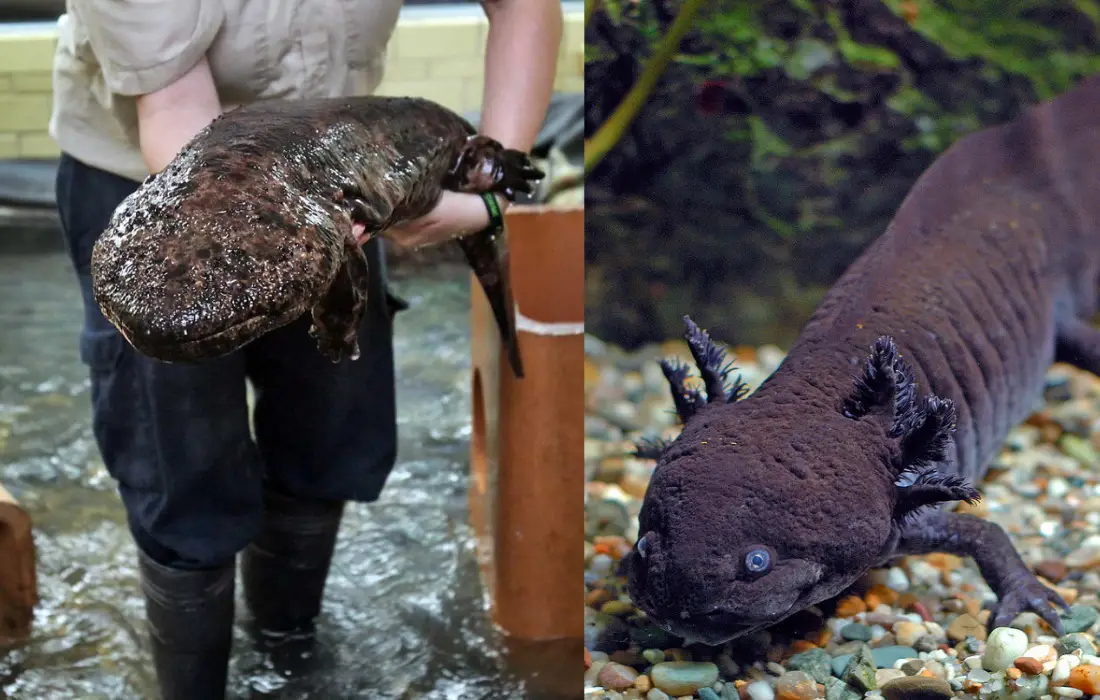In the serene rice paddies of Japan, where the harmony of nature blends with the age-old traditions of agriculture, a local rice farmer stumbled upon a creature of legend.
It was not the mythical Kappa from Japanese folklore, nor was it a colossal axolotl as some enthusiasts might hope.

This was the elusive Japanese giant salamander, an amphibian giant that has quietly navigated the streams and rivers of Japan for millions of years.
The discovery was as unexpected as it was astonishing. Amidst the verdant fields, a farmer’s routine day was transformed into a moment of wonder when he encountered the massive salamander.
This gentle giant, with its mottled skin and ancient lineage, was a living testament to the biodiversity hidden within Japan’s rural landscapes.
The difference and similarities between this salamander and an axolotl
While the Japanese giant salamander and the axolotl may share some superficial similarities, they are distinct species with unique characteristics.
The giant salamander (Andrias japonicus), found in Japan, is one of the largest amphibians in the world, capable of growing up to 1.5 meters in length.
It is fully aquatic, preferring the cool, flowing waters of rivers and streams. In contrast, the axolotl (Ambystoma mexicanum) is much smaller, reaching only about 30 centimeters, and is native exclusively to the lake complex of Xochimilco near Mexico City.
Unlike the giant salamander, axolotls are neotenic, meaning they retain their larval features throughout their life, such as their gills and dorsal fin.
While both are fascinating creatures, it’s important not to confuse the critically endangered Japanese giant salamander with the often domesticated and beloved axolotl.
What’s a Giant Salamander?
The Japanese giant salamander, scientifically known as “Andrias japonicus”, is a species steeped in history and ecological importance.
With individuals capable of growing up to 1.5 meters in length, they are among the largest amphibians on the planet. Their presence in the wild is a symbol of environmental health and the continuity of natural processes that have been ongoing for eons.
Final Thoughts
This encounter with the Japanese giant salamander serves as a reminder of the wonders that lie in our natural world.
As we share this story through videos and social media, we not only celebrate the discovery but also raise awareness about the importance of conservation.
This is not just the tale of a rice farmer and a salamander; it is a narrative about our connection to the earth and the responsibility we carry to protect its inhabitants.
Watch the incredible video of the giant salamander’s discovery and join the conversation about conservation and biodiversity.
Let’s ensure that these magnificent creatures continue to thrive for generations to come.
Source
The plight of the Japanese giant salamander https://www.theguardian.com/environment/2023/jan/12/richard-pearce-save-japanese-giant-salamander-aoe.
Japanese giant salamander – Wikipedia. https://en.wikipedia.org/wiki/Japanese_giant_salamander.
Japanese Giant Salamander Profile (with Images) – Ocean Info. https://oceaninfo.com/animals/japanese-giant-salamander/.


